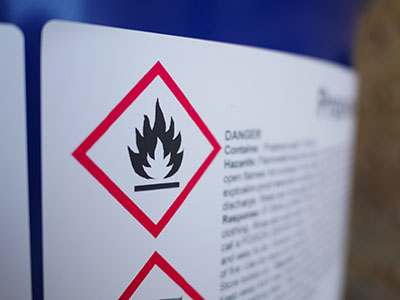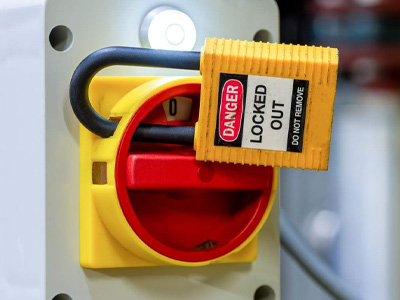 |
Preventing Violence at the Workplace |
0.50 |
This course covers the basics of workplace violence protection, including the four types of workplace violence and the appropriate responses to each. |
 |
Construction Hazards |
0.50 |
This course covers the basics when discussing construction hazards you may see daily when working on a construction site. Preventative measures for falls and falling objects, electrical work, as well as excavations will be discussed throughout. |
 |
Hazard Communication Basic |
1.00 |
This course covers the basics when it comes to hazard communication. The topics will range from the Hazard Communication Standard to the labeling of hazardous materials. |
 |
Hazard Communication Basic (Short) |
0.25 |
This course covers the basics when it comes to hazard communication. The topics will range from the Hazard Communication Standard to the labeling of hazardous materials. |
 |
Heat Illness |
0.75 |
This course covers the basics when it comes to heat-related illnesses. The topics discussed will include warning signs, types of heat-related illnesses, and how to prevent these illnesses. |
 |
CERT Unit 2: Organization |
0.75 |
This course covers the CERT organizational structure, the Incident Command System (ICS), the one-scene size-up process, and how to use CERT standard documents. |
 |
Safety Training for Supervisors |
0.75 |
This course covers the different challenges that supervisors face on the job site. You will also learn how to properly identify hazards within your work site and be able to investigate incidents where hazards harmed a worker. Finally, you will learn how to install safe practices in your team so that everyone is protected and the job runs safely. |
 |
Respiratory Protection Awareness |
0.50 |
This course covers the different types of respirators and their purposes, as well as OSHA standards and the reasons why using a respirator would become necessary. |
 |
Creating a Safety Program |
1.75 |
This course covers the elements of a safety program, accident investigation, hazardous communication standard, and new employee orientation for construction detailing site hazards. |
 |
Introduction to Warehouse Operations |
1.00 |
This course covers the essential skills and knowledge needed to excel in a warehouse environment including the basics of warehouse operations, safety protocols, inventory management, and efficient logistics practices. |
 |
The Globally Harmonized System (GHS) for Hazard Classification and Labeling |
0.25 |
This course covers the Globally Harmonized System for Hazard Classification and Labelling. The Globally Harmonized System for Hazard Classification and Labelling, or GHS, is a common and coherent approach to defining and classifying hazards and communicating information on labels and safety data sheets. GHS provides the underlying infrastructure for the establishment of national, comprehensive chemical safety programs. |
 |
NIEHS Driving Hazard Awareness |
0.17 |
This course covers the hazards of driving and what you can do as a driver to avoid these hazards. When you are on the road, there are a variety of factors that go into your overall safety. Being aware of other drivers and being conscious of your own driving increases your overall safety. |
 |
Protecting Yourself While Responding to Earthquakes |
2.00 |
This course covers the importance of earthquake safety and protecting yourself before, during, and after an earthquake. It also covers how first responders should keep themselves safe when responding to an earthquake scene. |
 |
Ergonomics for Food Service and Retail |
0.50 |
This course covers the importance of ergonomics, specifically in the food service and retail industries. This course will cover topics such as the benefits of ergonomics, Work Related Musculo-Skeletal Disorders (WMSDs), ergonomic risk factors, and how to reduce hazards from awkward positions and heavy lifting. |
 |
Scaffold and Ladder Safety Training |
1.00 |
This course covers the importance of ladder and scaffold safety, common hazards when using scaffolding and ladders and how to prevent serious injury. |
 |
Scaffolding Safety |
0.50 |
This course covers the importance of scaffold safety, common hazards when using scaffolding, and how to prevent serious injury. |
 |
Incident Command System (ICS) Overview for Executives and Senior Officials |
2.00 |
This course covers the Incident Command System and the different departments that fall under it. It also covers the roles of officials and staff under the ICS and how to incorporate them into incident management. |
 |
Incident Command System ICS-100 |
0.50 |
This course covers the Incident Command System, a systemized and standardized approach to incident management. The Incident Command System works for small and large incidents. |
 |
Lockout-Tagout: Control of Hazardous Energy |
0.50 |
This course covers the procedures of Lockout-Tagout. You will learn what Lockout-Tagout is, when to apply it, as well as the process that goes along with it. |
 |
Construction Safety & Prevention Program: Safety Inspection Procedure |
0.50 |
This course covers the process of inspecting the workplace. This includes who is responsible for the inspection, what you should look for, and what happens afterward. |
 |
Construction Safety & Prevention Program: OSHA Inspections |
0.50 |
This course covers the process of OSHA inspections, the penalties incurred when a workplace does not satisfy OSHA standards, and how to properly respond to an OSHA inspection. |
 |
Forklift Safety |
1.00 |
This course covers the proper handling and safe operation of forklift truck machinery. This includes some of the hazards operators face as well as tips for proper load centering and proper load capacities to prevent tip-overs. |
 |
Sanitation and Hygiene |
0.25 |
This course covers the proper manufacturing practices to ensure good sanitation, how to achieve proper hygiene among personnel, and how to identify sanitation and health problems in the workplace. |
 |
Pesticides and Chemical Safety |
0.50 |
This course covers the safe use of pesticides, including pesticide selection, safe storage, and disposal, as well as recommendations for preventing pesticide poisoning. The advice provided in this course is equally applicable to household use of pesticides as it is to commercial or agricultural uses.
It is just one of many health and safety courses we offer. This course will help you learn about best practices to keep yourself safe and healthy when on the job or at home. |
 |
Permit-Required Confined Spaces |
1.00 |
This course covers the safety basics while working in permit-required confined spaces. You will learn the differences between a confined space and a permit-required space, as well as how to identify potential hazards in confined spaces and the safeguards that go along with them.
|


























